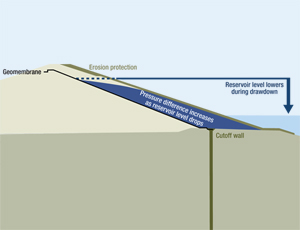The board of Tampa Bay Water has approved staff recommendations for an estimated $125-million repair program for the agency’s four-year-old, 15.5-billion-gallon C.W. “Bill” Young Regional Reservoir. The earthen structure, which cost roughly $140 million to build, has been experiencing significant cracking since late 2006.
The authority also is moving ahead with a lawsuit against the three lead members of the project’s design and construction team: designer HDR, Omaha; contractor Barnard Construction Co., Bozeman, Mont.; and construction manager Construction Dynamics Group, Columbia, Md.
The agency reports that cracks affect roughly 40% of the reservoir’s interior lining. The problem centers around the interior soil-cement seam, designed as an alternative erosion-control component.
The erosion-control system comprises a soil wedge between the interior soil cement layer and a geomembrane exterior, which protects the reservoir’s embankment. Last summer, an investigation by Black & Veatch, Overland Park, Kan., found water trapped in the soil wedge.
“Water gets underneath the interior liner and is trapped between the soil-cement and the geomembrane cutoff wall,” says Jon Kennedy, manager of engineering and projects for Tampa Bay Water. “It is putting tremendous pressure on the liner when we draw the reservoir down.”
HDR added the soil wedge to its design at the urging of the Florida Dept. of Environmental Protection. DEP officials have focused their public comments on HDR’s role in the project. Kennedy says Tampa Bay Water is looking at the design flaw, contractor and “those who provided the construction inspection.”
The agency is considering three repair schemes: adding drains to the soil wedge and replacing the soil-cement layer; adding weight to the existing structure to prevent further movement of the soil-cement layer and soil wedge; and removing the wedge and reapplying a well-drained, soil-cement erosion-control layer atop the geomembrane.
Tampa Bay Water expects work to start in 2012 and last about two years, when the reservoir will be empty. “A competitive design and construction process…will include an independent, expert peer-review group,” said Gerald Seeber, general manager of Tampa Bay Water.
“HDR is fully cooperating with Tampa Bay Water to find a resolution,” says a spokesperson. “We cannot comment further.” Barnard did not return calls for comment. The contractor currently is working on a $61.7-million contract for the Peace River Regional Reservoir in DeSoto County, Fla. That project, whose engineer is MWH Americas of Broomfield, Colo., also features a soil-cement lining but includes a drain.



Post a comment to this article
Report Abusive Comment